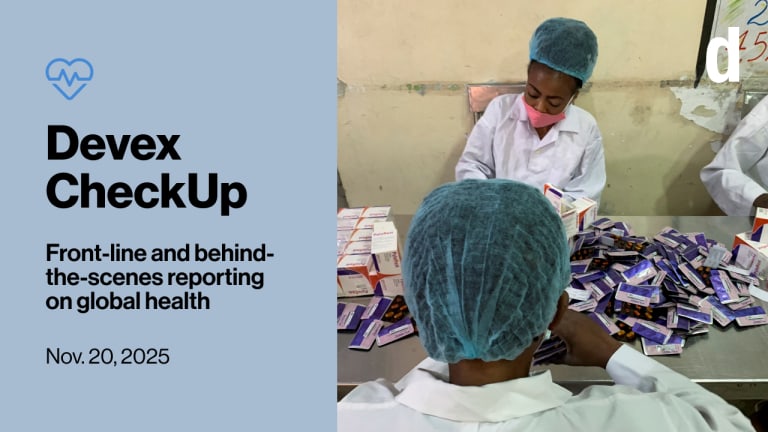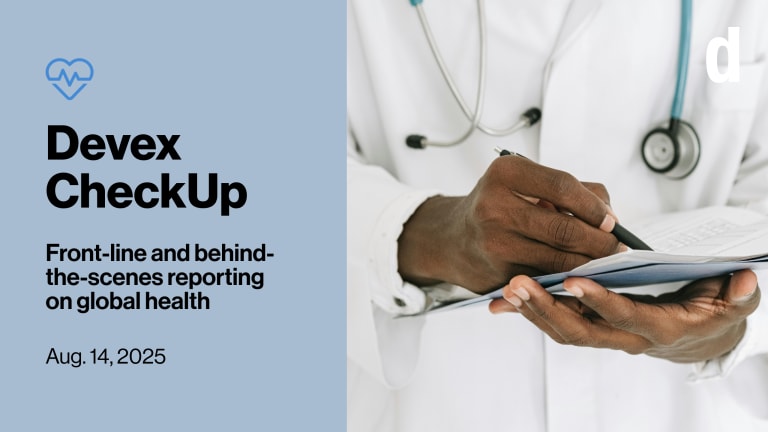Presented by Global Remission Coalition

How can countries hit hard by significant donor cuts to global health recover from the crisis? There are no simple answers.
My colleague Andrew Green, who closely followed financing discussions at the 78th World Health Assembly, tells me that several panels and side events at the recently concluded Geneva gathering highlighted an urgent need for countries to increase their domestic resources.
“The time for domestic financing is indeed now, if not actually yesterday,” Dr. Bruce Aylward, an outgoing World Health Organization assistant director-general, said at one side event.
But that’s easier said than done. The funding gap is so huge that countries wouldn’t be able to fill it. Raising taxes on harmful products, such as tobacco, can help, but it will take time for countries to implement. And some countries are so deep in debt that there’s not much left to allocate for everything else, including health.
This is putting health ministries in a tight spot. In Ethiopia, one official said they’ve been unable to convince their finance minister to allocate funding for health systems strengthening.
The situation could leave more people spending out of pocket for health care, and push them into poverty. WHO’s Kalipso Chalkidou said governments should look out for these people and protect them, but that, again, is easier said than done, given the poor data systems in many countries.
Philanthropy can help, but most agree it wouldn’t be able to fill the gaps either. If there’s one thing it can do: “Mitigating harm in the short term by keeping the lights on on the most critical programs, yes, philanthropy can help,” Anil Soni, chief executive officer of the WHO Foundation, said during a Devex side event.
Read: Can domestic financing solve the global health funding crisis?
Read more: As aid declines, Africans must take a greater lead on health financing
ICYMI: Can philanthropy save global health?
What you know can’t hurt you
Speaking of data, countries should invest in and own their data systems, and use them to inform decision-making and not just for donor reporting purposes, according to Nelima Otipa, who uses data to guide her work in public health.
When the U.S. Agency for International Development paused and terminated thousands of awards, health ministries were not just left with shuttered clinics and disrupted health programs. Some of them also lost access to critical health data, which made it difficult for them to allocate resources or maintain services, she explained in an opinion piece for Devex.
“I've witnessed firsthand how countries with robust, locally controlled health care data infrastructure navigate funding transitions successfully, while those without it struggle to maintain even basic services,” Otipa writes.
Opinion: Robust health data today avoids fragile health systems tomorrow
Food for thought
“Reproductive health, family planning, it's about sex, it's about human beings. So why do we deprioritize it when it seems inconvenient?”
— Dr. Samukeliso Dube, executive director, FP2030Organizations working on reproductive health and family planning braced for tough times when U.S. President Donald Trump won the elections. During his first term in office, Trump reinstated and expanded the “Mexico City Policy,” aka the global gag rule, a policy that blocks U.S. federal funding to international nongovernmental organizations that provide abortions or information about them, even if other donors fund these services.
But USAID’s termination of thousands of awards added to the challenge. Not only are family planning organizations losing funding, they’re also seeing disruptions in the systems that they’ve long relied on to deliver services.
If the funding is not filled and the programs reinstated, they fear it could lead to an additional 34,000 maternal deaths and 116,000 unsafe abortions.
Read: Why the US aid cuts are a moment to prioritize reproductive health
Mixing it up
Since 2022, Gavi, the Vaccine Alliance has been working with humanitarian organizations to help bring routine vaccinations to “zero-dose” children — those who have not received a single vaccine — especially in areas affected by conflict or mass displacement, where national immunization programs often can't reach them. This is crucial given that there are 14.5 million zero-dose children globally in 2023, and some 55% of them live in conflict-affected regions.
How does it work? The vaccines come from the national supply co-financed by Gavi, while humanitarian partners negotiate access and help build relationships in the communities for vaccinations to proceed.
The approach appears to work. In the village of Bopo in southwest Cameroon, where there’s an ongoing conflict and health workers were unable to visit for nearly a decade due to the risk of kidnapping, several children received their first vaccine dose, protecting them from diphtheria, tetanus, and pertussis, Devex contributor Catherine Davison reports.
The model is still evolving, with Gavi still working to balance its need for oversight and flexibility. It also needs to figure out how to cover children who missed their vaccinations, but fall outside the age limit of the program. Gavi also needs to secure sufficient funding to continue and potentially expand this work.
Read: How Gavi is reaching ‘zero-dose’ children in conflict areas (Pro)
+ Curious about the insights that drive global development? Experience the power of Devex Pro with a 15-day free trial. Explore expert analyses, unlock hidden funding opportunities, connect with key players at exclusive events, and access a wealth of knowledge you won't find anywhere else.
One big number
109
—That’s how many member states voted to adopt WHO’s first global action plan on climate change and health on Tuesday. No one voted against, but 19 abstained.
Countries from the Eastern Mediterranean region argued that a consensus on the action plan had not been reached. They said the plan lacked sufficient consultation and that several countries still had concerns about parts of the text.
Read: WHA passes first climate action plan after tense vote
What comes first
When Bill Gates announced his $200 billion giving plan for the next two decades in New York, artificial intelligence naturally came up.
“What many people probably don't appreciate is how dramatic the use of AI will be for equity,” he said, highlighting its potential across sectors, from health to farming advice.
This is already happening in several parts of the world. In a remote district in India, patients suffering from unexplained fever or breathing problems were able to find relief after an AI-powered diagnostic tool helped doctors accurately diagnose them with tuberculosis. And it’s not just TB. The hospital using the technology saw an increase in the diagnosis of other illnesses, such as pneumonia, COVID-19, and lung cancer, Devex contributor Cheena Kapoor reports.
But while investing in AI, governments and philanthropists should work to meet some of the most basic needs on the ground, such as the availability of reliable power, so health workers can use the technology handed to them. As one health worker from Kenya said during a Devex WHA78 side event last week, they need power banks to keep their phones from dying when doing digital health assessments.
Read: How AI is transforming medical diagnosis in India’s tribal regions
Watch: Can AI help lighten the load for community health workers?
ICYMI: Risk-averse Gates bets his fortune on the future
What we’re reading
A vaccine for gonorrhea will be rolled out in England and Wales. [The Guardian]
Cholera has claimed more than 1,000 lives in South Sudan, and there are now over 56,000 cases across 45 of the country’s 78 counties. [The Telegraph]
U.S. health secretary Robert F. Kennedy Jr. announced on social media that COVID-19 vaccines will no longer be recommended for pregnant women and healthy children. [CNN]








